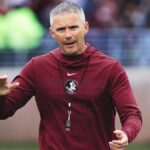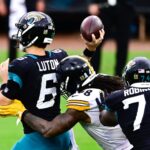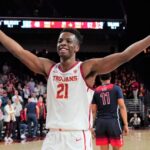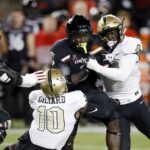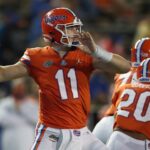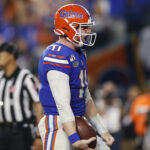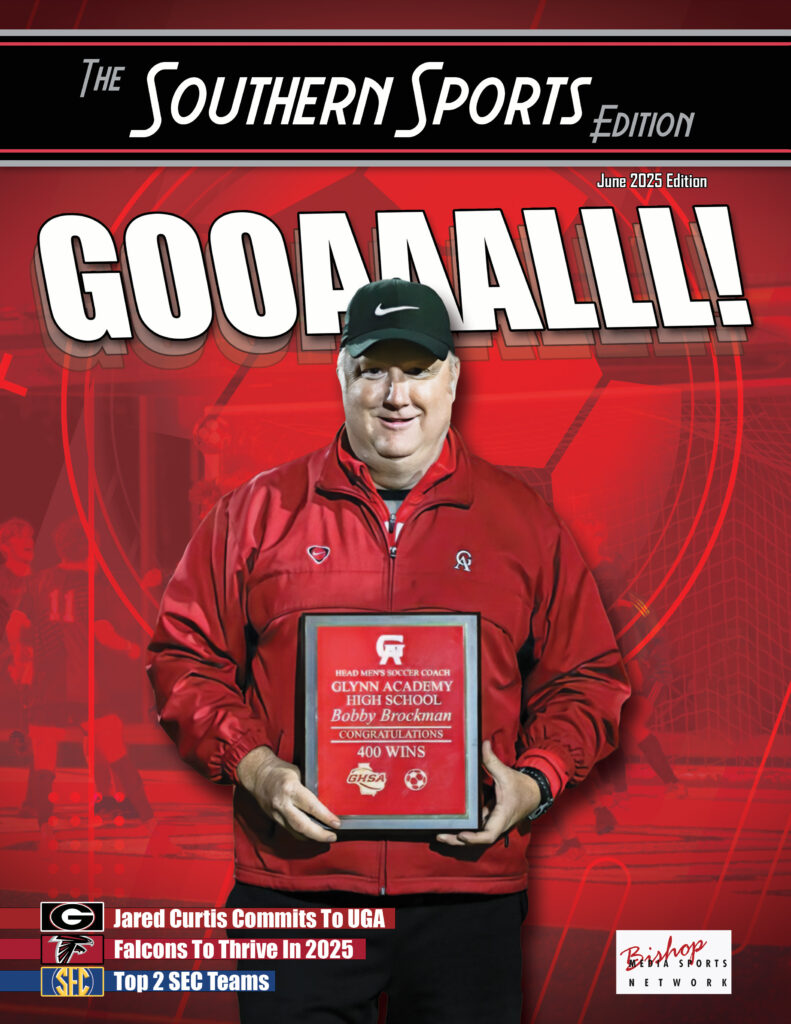Florida Recruiting Wars
 By: Robert Craft
By: Robert Craft
TheSouthernSportsEdition.com news services
With the Early Signing Period less than a month away, I want to look at the Big Three in Florida’s potential recruiting classes for 2021.
The Current ranking for the Miami Hurricanes is 13th in the nation and fourth in the ACC with 21 commits.
The Canes currently have 1 running back, 5 receivers, 3 offensive linemen, 4 defensive linemen, 3 linebackers, 2 defensive backs, 2 athletes and 1 kicker.
Coach Diaz has done an excellent job of keeping the top talent in South Florida to commit to Miami.
Leonard Taylor, the number two player in the state and ninth nationally, is the anchor to an outstanding class. The Canes have commitments for three of the five heralded players from Miami Palmetto (Taylor, Bashard Smith WR, and Savion Collins DE).
Miami has 19 current commits from the State of Florida and 16 of the 19 are from South Florida.
Key players in this class: James Williams 5-star safety, Romello Brinson high 4-star wide receiver and Laurence Seymore 4-star offensive guard.
Miami needs to find a quarterback, two or three more offensive linemen and 3 or 4 more defensive backs.
When the dust settles after the early signing period, I predict the Canes will be in position for a top 10 class.
The Florida State Seminoles are currently ranked 28th and in the ACC with 15 commits.
The Seminoles currently have 1 quarterback, 4 receivers, 3 offensive linemen, 3 defensive linemen, 1 linebacker and 3 defensive backs.
Coach Norvell must think he is still at Memphis with the star power of the current class. FSU (Five Star U) has ZERO five stars in this class, four 4-stars and eleven 3-stars.
The Seminoles only have six recruits from the State of Florida.
The disaster on the field has affected recruiting. If Norvell wants to be competitive on the field it starts with recruiting top players in the States of Florida and Georgia.
Norvell may want to utilize the transfer portal this season to acquire some talented players who are dissatisfied with their current situation. The current roster has six five-stars and a top 10 composite ranking but only two wins on the field.
The Seminoles need to add 4 to 5 offensive linemen, 2 receivers, 3 defensive linemen and 2 defensive backs. Norvell sure looks to have his work cut out for him.
FSU will finish the 2021 with a class ranked around 25th. Maybe FSU fans are wishing they didn’t fire Willie so quickly!
The University of Florida Gators are currently ranked seventh in the nation and fourth in the SEC with 26 commits.
The Gators have 2 quarterbacks, 6 receivers, 5 offensive lineman, 5 defensive linemen, 2 linebackers, 5 defensive backs, and 1 athlete.
When Dan Mullen arrived in Gainesville, he was not known as a top recruiter but he had made smart hires. The Gators will carry over the success on the field into recruiting.
The Gators snagged the two remaining players for Miami Palmetto in Jason Marshall and Corey Collier. The Gators currently have 18 commits from Florida and 3 from Georgia.
Florida may have lost a commitment from 4-star linebacker Chief Borders out of Franklin, GA to Sanford.
Players to watch for commitment are 4-star linebacker Xavian Sorey and 4-star safety Terrion Arnold out of Tallahassee, it’s a Florida – Alabama battle for both players.
The Gators are in good shape to finish with a top 10 class. My prediction is they will have the sixth ranked class in the nation.
Florida is one of the richest recruiting states in the country, and if the Big Three want to stay in the Big Three, they must recruit the State of Florida first.
Southern Charm
 By: Kenneth Harrison
By: Kenneth Harrison
TheSouthernSportsEdition.com news services
Week 11 of the NFL season is in the books.
The contenders are starting to rise to the top and separate themselves at this point.
Let’s take a look at the AFC South and grade the teams thus far.
Jacksonville: The Jaguars (1-9) have the second worst record in the league behind the winless New York Jets.
The lone win came in the season opener, so they’ve lost nine consecutive games.
Quarterback Gardner Minshew fractured his right thumb in Week 7 against the Chargers.
Jake Luton has been playing since then and he’s struggled. In his last two games he’s 34 of 72 passes for 320 yards, 1 touchdown and 5 interceptions.
Minshew may return next week against Cleveland. One bright spot has been rookie running back James Robinson. He’s rushed for 762 yards (3rd) and 5 touchdowns.
The Jags are 27th in total offense and 30th in total defense.
The best thing they have going for them is they can possibly land the top pick in the draft. At this pace they should pick no worse than second. Grade: F.
Indianapolis: The Colts (7-3) are tied for the division lead.
Veteran QB Philip Rivers is in his first season in Indy.
He has a problem turning the ball over and he has thrown 8 interceptions up to this point.
They don’t have a big-time playmaker on offense. The Colts have a couple of talented backs in Nyheim Hines and Jonathan Taylor.
They are coming off of a good overtime win against Green Bay Sunday.
The defense is elite, ranked second in total defense. They allow less than 300 yards per game and 21 points per game.
The offense isn’t bad, ranking 13th in total offense. This team is a contender because they have a great defense that can keep them in any game. Grade: B+.
Houston: The Texans (3-7) fired head coach Bill O’Brien after an 0-4 start.
He also traded All-Pro receiver DeAndre Hopkins to the Arizona Cardinals in the offseason.
Quarterback Deshaun Watson is a very good young quarterback, but he does not have much to work with. Wide receiver Will Fuller V has over 700 receiving yards and Brandon Cooks has 634.
Houston is 18th in total offense and defense.
They are 2 – 1 in their last three games. The one loss was 10-7 to the Browns. They can realistically win half of their final six games that include Detroit, Chicago and Cincinnati.
They are not going to make the playoffs so that might be pointless. Grade: D.
Tennessee: The Titans (7-3) look like they are picking up where they left off last season.
They play old school football by running the ball and controlling the clock.
Running back Derrick Henry leads the league in carries (229), rushing yards (1,079) and he has 3 rushing TD’s (3rd).
QB Ryan Tannehill is good enough to make plays when the run game isn’t working. He’s thrown for 22 touchdowns; 4 picks and he’s completing 71% of his passes.
They just beat the Ravens in overtime, so they play well against good teams.
They did lose to Indy 34-17 two weeks ago. They play again this week and they cannot afford to get swept. Grade: B.
Welcome To The League
 By: JJ Lanier
By: JJ Lanier
TheSouthernSportsEdition.com news services
With everything going on in the world to go along with a lack of star power in this year’s draft, it would be completely understandable if you forgot the NBA Draft hadn’t taken place yet.
Honestly, the only reason I remembered is I haven’t purchased NBA 2K21 yet because the rosters couldn’t be up to date since there had been no draft (or free agency and trades).
As I’ve mentioned in the past, I’m not a fan of giving out grades when to comes to drafts.
I know they’re interesting to read, which is why most media outlets post them, but unless it’s just a no brainer pick, or one that makes absolutely no sense, it’s three or four years before you can really make any judgements.
So, instead of telling you how well or poorly the Atlanta Hawks and Orlando Magic did, here are a few remarks on the type of player each team is getting.
Atlanta Hawks
Oneyka Okongwu, C, USC. The former 1st team All-PAC 12 player was largely considered to be the best low post player in the draft.
Like most young big men with similar size and athleticism his strength is on defense, however his offensive skillset is farther along than most of his peers.
I imagine the plan is for Okongwu to back up Clint Capela while he adjusts to the NBA, but if his development is quicker than expected Capela could become expendable, something that may be appealing to Atlanta at the trade deadline.
There’s a very good chance the Hawks drafted their long-term answer down low.
Skylar Mays, G, LSU. With the NBA’s emphasis on drafting young players based on potential, hopefuls like Mays- four-year players with NBA level skills- oftentimes find themselves waiting until the second round before they hear their names called, if at all.
Mays, who started all four years at LSU and was named 1st team All-SEC this past season, is certainly good enough to play at the NBA level, the only question is whether he’ll get a chance to prove himself with Atlanta.
Not many players drafted in the 50th spot hang around, Mays has the potential to be an exception to the rule.
Orlando Magic
Cole Anthony, G, UNC. As a devout parishioner from the church of ABC (Anybody But Carolina) I was able to watch Anthony a few times during his lone, injury riddled season in Chapel Hill.
I try not to make player comparisons, but the best way I can describe Anthony’s game is “Kyrie Irving Lite”.
Anthony has great handles, can get to the rim with relative ease, and has a knack for making the “no, what are you thinking…. yes, great shot” shot, a la Irving.
But, also like Kyrie, the former Tarheel tends to forget he has teammates he can pass the ball to and avoids playing any semblance of defense.
Now, In Anthony’s defense, he wasn’t surrounded by a plethora of talent at Carolina this past season, so I understand to a point why he was the volume shooter he was.
However, I have a feeling things wouldn’t have been all that different, even if the talent level had been greater.
The Magic may have just found their most beloved, and frustrating, player on their roster.
We’ll see how these guys turn out over the next few years. For both the Hawks and Magic, they’re hoping the 2020 Draft will be a bright spot in an otherwise dreary year.
Can I Wear That Jacket?
 By: Kipp Branch
By: Kipp Branch
TheSouthernSportsEdition.com news services
This year’s telecast of the Masters on CBS recorded the major tournament’s lowest final-round numbers since 1957, extending a streak of soft sports TV viewership numbers.
The broadcast averaged a 3.4 rating and 5.59 million viewers, according to Nielsen.
That is about 51% lower than last year, when Tiger Woods recorded a comeback win, and also well below the previous lows of 6.7 in 1980 and 11.05 million viewers in 2017. (Viewership has been tracked since 1995.) In 1957, CBS aired one hour of coverage and drew a 3.0.
I enjoyed The Masters. I liked the fact that three of golf’s Major Championships were able to reschedule and play in 2020. The Open Championship cancelled the 2020 tournament early on in the Covid-19 pandemic.
Dustin Johnson is the number one golfer in the world according to the World Golf Rankings.
With the win at Augusta he capped a stellar stretch in the majors this year finishing 2nd in the PGA Championship, and 6th in the US Open.
Johnson has now won the US Open and The Masters, and has runner-up finishes in the PGA and Open Championship.
The play has been consistently very good since August where has finished no worse than 6th in seven starts on tours with two wins.
Johnson was born in Columbia, South Carolina and played his golf at Coastal Carolina University so the proximity to Augusta National made last weekend’s win very special to Johnson.
Johnson grew up in Irmo, South Carolina. His childhood dream was to win The Masters.
Once the Green Jacket was placed on him by Tiger Woods, he became very emotional and barely could speak a word.
That raw emotion from Johnson was very good to see. Johnson is known as stoic player, who just handles his business on the golf course and in 2020 style that post tournament side of Johnson was something that I wish we could see more of on the PGA tour.
Back to the final round of The Masters, Johnson carded a final round of 68 that left him at 20-under 268, beating the previous tournament best of 18-under set by both defending champion Tiger Woods, in 1997, and Jordan Spieth, in 2015.
Johnson shot four rounds under par for the tournament. He has played 11 straight rounds under par at Augusta which is a record.
Johnson became the first world number one to win at Augusta since Tiger in 2002.
Don’t let the low television ratings from last weekend put a damper on the quality of golf that was played.
Those of us who watched saw a record-breaking performance by Dustin Johnson, who has rapidly become one of my favorite golfers on the tour.
Johnson’s work ethic is better than most on the tour. At age 36 Johnson is in his golfing prime. Many more wins could be on the horizon.
Brooks Koepka called out Dustin Johnson as only having one major championship going into the final round of the PGA Championship in August and it backfired on Brooks.
Koepka finished tied for 7th at 10 under par at The Masters. Good showing but it was 10 strokes behind your 2020 Master Champion Dustin Johnson, who now has two majors under his belt.
Dustin Johnson is the best golfer in the world and he may stay there for a while. He has The Green Jacket to prove it.
He will defend in April and this time we will have Azalea’s and Dogwood’s blooming once again.
Yellowstone is my favorite show on TV right now and in grand Rip Wheeler fashion it is time to take 2020 on a trip to the Train Station.
All Smyles
 By: TJ Hartnett
By: TJ Hartnett
TheSouthernSportsEdition.com news services
I’m a sucker for puns. Good puns, bad puns (there are none), doesn’t matter. I love puns.
So, the endless possibilities that sprung to mind when the news broke on Monday that the Atlanta Braves had signed Drew Smyly made me, uh…grin.
In any case, Atlanta signed the left-handed hurler to a one-year, $11 million contract.
Alex Anthopoulos’ second signing of the offseason after bringing back righty Josh Tomlin on a one-year, $1 million deal (to hopefully pitch out of the bullpen, where he’s been very good, only).
It isn’t a massive splash, of course that’s never been Atlanta’s style, regardless of who the general manager is. However, it’s a solid move to begin the process of going after a 4th straight NL East division championship (all due respect to Tomlin).
While eight figures seems like it might be a lot for a guy who certainly didn’t top the list of free agent pitchers (Trevor Bauer is about to make bank, though), Smyly is coming off of what was (or was almost going to be, had he not missed some time to injury) the best season of his career, pitching for the San Francisco Giants.
For a 31-year-old pitcher, that’s a pretty impressive feat and it’s likely owing to the fact that his velocity has somehow actually increased as he’s entered his 30s.
Granted, the 2020 season was an anomaly and Smyly probably had more gas in the tank on the whole (his longest outing was just 5 1/3), but the fact that 2019 was a good run for him and he took further steps the next season speaks to his improvement. It’s likely the combo of the two seasons that put him on Anthopoulos’ radar.
Now, you’re probably thinking that only one start into the 6th inning coupled with a good-but-not-jaw-dropping 3.42 ERA isn’t anything to get excited about, and to be fair, you’re absolutely correct. But this signing isn’t the kind of signing that’s supposed to get you all riled up.
Smyly is essentially going to be expected to play the role of the capable veteran in the rotation, a role that was desperately unfilled in 2020, much in part to Cole Hamels’ inability to get healthy enough to earn that $18 million that Atlanta had to pay him for three innings this year.
In short, this was a move to acquire more depth, and it comes at a position that was horrifically devoid of that, particularly as the year went by.
And to that end, Smyly is a low(ish)-risk, high(ish)-reward signing: the deal is for a single season (which the higher-tier pitchers won’t be looking at this early in the offseason), not for no money but cheaper than the aforementioned Hamels was or plenty of other pitchers will be.
While Smyly is unlikely to be in the Cy Young conversation for next season and there is a history of injury, he’s capable of being a solid hand who can rack up 10+ wins with a sub-4.00 ERA.
Every playoff-hopeful team needs one or two and the Braves had none last year. This is just the kind of piece that could potentially make a difference, especially if the 2021 season goes ahead as planned and they get a full 162-game schedule in (can you imagine if Atlanta had had to play a full complement of games with the rotation they had for most of last year?).
This signing allows Atlanta to devote more resources to either resigning or replacing Marcel Ozuna this offseason and hoping that the big splash in the pitching rotation comes when Mike Soroka fully recovers from his injury towards the beginning of next season.
Sunshine Saturday
 By: Robert Craft
By: Robert Craft
TheSouthernSportsEdition.com news services
Here’s a Florida College football fan’s guide to this week’s games as the 2020 college football season is on its way into Week 12.
Last Saturday, Florida showed no signs of hangover from the World’s Largest Cocktail Party, by trouncing Arkansas 63-35.
Senior Quarterback Kyle Trask keeps breaking SEC records with his sixth game with four or more touchdowns.
The Gators travel to Nashville to take on the Commodores of Vanderbilt. Florida opens as a 31.5 point favorite.
Can Kyle Trask continue to play at an All-American level? Can the Gators put the game away early and rest some starters? My predictions: Trask throws for 5 touchdowns and they roll Vandy 45-13.
Last Saturday, FSU fans got a glimpse of their future. Chubba Purdy started the contest versus the North Carolina Wolfpack. Purdy played well, going 15 for 23 for 181 yards and 2 touchdowns, but it still wasn’t enough as the Wolfpack dominated the Noles 38-22.
FSU hosts number four Clemson at noon in Doak Campbell Stadium and the Noles are a historic underdog in the contest.
The Tigers open as a 32.5-point favorite over the 2-6 Seminoles. FSU was a 26-point underdog to Clemson last season, which was believed to be the largest point spread in school history.
Clemson suffered their lone loss two weeks ago to Notre Dame without star quarterback Trevor Lawrence.
Their signal caller is expected back and that means bad news for the Noles. Clemson is a national powerhouse and Florida State is a national landfill.
In my opinion, this is the worst Florida State team in program history! Clemson 52 FSU 20.
Last Saturday night in Orlando, UCF manhandled Temple 38-13.
The Knights opened the game with a strip sack and never looked back. The Knights offense did not look like it was clicking until the start of the 3rd quarter, when Dillon Gabriel found Marlon Williams for an air mail touchdown.
For UCF, standards this season have been disappointing. The Knights are 5-2 after being picked by many to win the AAC conference.
The Knights and Bearcats renew their revere on Saturday in the Bounce House. With very limited capacity, the Bounce House during the 2020 season has not provided their normal home field advantage.
The Bearcats come into this game looking to remain unbeaten and take another step towards a potential playoff spot. Cincy opens as a 4-point favorite.
This is a battle between UCF’s offense and Cincinnati’s nationally ranked defense. The Bearcats are outscoring their opponents 212-57, with an average margin of victory of 31 points per game.
Those numbers are against quality offenses like Memphis, Houston and SMU.
UCF will score points, but Cincinnati is too legit this year. Give me the Bearcats 48 Knight 38.
The Miami Hurricanes game against Georgia Tech has been postponed due to COVID.
The Canes are coming off an impressive come from behind victory over Virginia Tech last Saturday.
D’Eriq King led a second half comeback to keep the Canes in the mix for the ACC title game. King makes Miami the U again.
So, sit back, buckle up and enjoy some college football this weekend.
If you are a Knight expecting a battle in the Bounce House, a Seminole praying for a miracle, a Gator witnessing a massacre or a Hurricane just waiting to troll the other fan bases, live college football offers us an escape during these stressful times.
The Heisman Race
 By: Kenneth Harrison
By: Kenneth Harrison
TheSouthernSportsEdition.com news services
Normally this time of year means the college football regular season is almost over.
Due to the pandemic, the season was delayed for several conferences like the Big Ten and Pac 12. I’m going to take a look at the top five Heisman Trophy candidates.
Kyle Trask/ Florida: I feel like he should be the hands down favorite at this point. It’s hard to believe this guy was sitting on the bench behind Feleipe Franks.
Earlier in the season I said he’s this year’s Joe Burrow. I don’t think anybody can match Burrow’s video game like stats from 2019 but I’m talking about the drastic improvement he made. Also, both of them were not expected to play at that level going into their final season.
They have had the LSU game postponed due to several players on the team having COVID. I hope that game can get played in December so Trask can play the maximum amount of games.
He led the Gators to a win over No. 5 Georgia that they desperately needed. The defense is not very good, so they basically have to outscore their opponents. Trask is basically good for at least four passing TD’s every game.
Trevor Lawrence/ Clemson: He’s the clear consensus as the best quarterback and number one pick in the upcoming NFL Draft.
Unfortunately, he had COVID and had to miss two games.
One of them was at No. 4 Notre Dame and that could have been his Heisman moment.
The Tigers like to run the ball with All-American running back Travis Etienne so that takes away from Lawrence’s stats.
If he plays well against Notre Dame in the ACC Championship that could catapult him to the top of the Heisman list.
Travis Etienne/ Clemson: I know this has become a quarterback award but he really deserves consideration.
He’s a true dual threat running back and his number are very good.
Mac Jones/ Alabama: He has the Crimson Tide undefeated (6-0) and he’s playing very well. Jones has thrown for 2,196 yards (8th), 16 TD’s (tied-13th), 2 interceptions with a 95.6 QBR (2nd).
He’s on the best team and I think Bama will finish undefeated. His stats are impressive because Alabama is another team that likes to run the ball. Najee Harris has over 700 yards rushing.
The LSU game has been postponed due to a Coronavirus outbreak in the program. We don’t know if that game will actually get played but that would be an easy win for Bama.
The only challenge should be against Florida in the SEC Championship.
Justin Fields/ Ohio State: The Buckeyes have only played three games because the Big Ten started the season late and the Maryland game was canceled.
Fields only has 7 games to make a case as the best player.
The Boss
 By: TJ Hartnett
By: TJ Hartnett
TheSouthernSportsEdition.com news services
A few years ago, I wrote a story about Augusta National allowing women to play golf at their club. I pointed out that the mere fact that it was news that women were breaking new ground in the 21st century was shameful in and of itself. Not that the move wasn’t important or newsworthy, because it was, just that it was ridiculous how late in the game (no pun intended) that the rule was being changed.
In a similar – but also distinct – manner, the Miami Marlins made the historic move to hire the first female General Manager in Major League Baseball history: Kim Ng.
Not for nothing, she will also be the first Asian-American GM and the first female GM in any of the four major North American Sports.
Ng comes to the gig with 30 years of high-level experience in the league, including the last nine as Major League Baseball’s senior vice president of baseball operations.
Before that, she spent 21 years in the front offices of the Chicago White Sox, the New York Yankees, and the Los Angeles Dodgers, showing up to be GM Brian Cashman’s right-hand woman in New York at the start of their World Series three-peat from 1998-2000.
At the time she was the youngest assistant GM in the league at just 29 years old and only the second woman to be hired to that gig.
In short, she is supremely qualified (the kind of qualifications that, let’s not kid ourselves, would have gotten her hired 10 years ago if she’d been a man), and while likely not the first woman that’s capable of handling the job, Derek Jeter and the Marlins have made her the first to rise to the top.
But with all that said, she’s got work to do. Ng is inheriting a Marlins team that made the postseason for just the third time in history on the backs of an incredibly young and gifted pitching rotation.
All eyes will be on her to solidify their position as a playoff team in a division populated by a Braves team that will be expected to repeat, Nationals & Phillies teams that will one day figure out what to do with their talent, and a Mets team with a new owner who will want to make a splash, and soon.
In the face of all that, it makes sense that Ng might want to make a splash of her own.
Incidentally, the Cleveland Indians have made it known that All-Star shortstop Francisco Lindor is on the market.
Ng and the Marlins have a farm system ready to be utilized, and Lindor is just the kind of franchise player that Miami has lacked since JT Realmuto was shipped off to Philadelphia.
Getting Lindor would be a no-brainer acquisition for any team. He’s been the best shortstop in baseball since his rookie season in 2015, even with his underproductive (for him) 2020 campaign.
The best part is – as Lindor is a free agent after 2021 – the Indians’ asking price would have to be (somewhat) reasonable.
Whether or not Ng could extend the shortstop is a whole different conversation, but the appeal of being able to trade for such a marquee name for only a handful of prospects and only one or two top-tier ones would be hard to resist.
Would Lindor put the Marlins over the top in the NL East? Absolutely not.
They’ve got too many holes in their lineup and bullpen for one elite player to change the entire future of the team, even one that made the playoffs last season.
But the positive spotlight is on the Marlins for once and going after Mr. Smile will keep it there.
I Have The Power
 By: Kipp Branch
By: Kipp Branch
TheSouthernSportsEdition.com news services
Thanksgiving is almost upon us in the pandemic-stricken football season of 2020.
Just this weekend alone you have four games in the SEC that have been postponed and scheduled for a later date due to the Coronavirus. Will we make it through the regular season?
Who knows that answer, but here are my SEC Power Rankings at this point of the season:
Alabama: The Crimson Tide hung 52 points on Texas A&M. Alabama hung 41 on Georgia before Georgia’s defense was officially exposed as a fraud.
Mac Jones and Najee Harris are Heisman candidates.
This defense is starting to come around, and there is no team in the conference that will stand in their way on a cruise to the SEC Championship.
Florida could pose some problems, but that defense can’t stop a faucet drip.
Nick Saban is still the best in the business. Alabama’s offense might be better than a couple of NFL teams that are in the Trevor Lawrence sweepstakes. SEC Champion and College Football playoff team.
Texas A&M: By virtue of beating Florida the Aggies land here.
The Aggies played awful against Alabama, but doesn’t everyone not named Auburn and LSU once every 8 years?
Jimbo Fisher is in position to get a College Football playoff bid without winning a conference championship if his team can run the table and finish 9-1 in this pandemic season. This team is improving weekly.
Florida: The Gators got over the UGA hurdle last week, but UGA left three TD’s on the field with awful QB play.
Kyle Trask may be the Heisman front-runner at the moment.
Dan Mullen needs to get something out of this season because Trask will not be back next year.
This defense can’t stop an elite team like Alabama. I see Florida finishing the season with a 10-2 record with a nice NY6 Bowl win over someone to be determined.
This offense is really good, and they just completed another 40-yard wheel route to a running back on Georgia.
Mullen still has a month to fix this defense before the Alabama SEC title game.
Georgia: UGA lands here by default.
The QB room is a mess and the defense can’t stop a good college passing offense.
UGA may finish 8-2 who knows, but last weekend in Jacksonville left a bitter taste in the mouth of the Bulldog Nation.
Carson Beck needs to get his shot Kirby.
Auburn: With the win over a bad LSU team Gus may have survived once again.
Perception is reality you know.
This is a team that did not score a TD against UGA.
Arkansas: The Razorbacks are the most improved team in the SEC.
“The Pit Boss” Sam Pittman is the SEC coach of the year. Arkansas is the SEC feel good story of the year. The Hogs are 3-3 currently and are a pretty decent football team.
Ole Miss: The Rebels have the third best offense in the SEC.
Once Lane Kiffin can shore up that defense with a couple of recruiting cycles look out SEC.
This is an exciting team to watch.
LSU: Yeah, we know the Tigers lost 14 players to the NFL draft, but damn this is LSU.
Covid-19 delayed a monumental beating from Alabama this weekend, but don’t worry LSU its coming in December.
Tennessee: You can shake 9-14 up in a bag.
Tennessee should be better than this.
Missouri: The Tigers are rebuilding and show signs of life.
South Carolina: Hugh Freeze is sitting by the phone Carolina fans.
Kentucky: Watching this offense is like staring at paint drying.
Mississippi State: The Air Raid is a dud in the SEC. The LSU game was fool’s gold against an awful defense.
Vanderbilt: Baseball season will start soon Vandy fans.
Power Rankings in Coastal Georgia seem to be a hot topic these days.
The Quarterback Room
 By: Robert Craft
By: Robert Craft
TheSouthernSportsEdition.com news services
The eighth ranked Florida Gators topped the #5 ranked Georgia Bulldogs on Saturday in the World’s Largest Cocktail Party, taking control of the SEC East at the midway point in the 2020 season.
Florida was led by Senior quarterback Kyle Trask. Trask completed 30 of 43 passes for 474 yards, 4 touchdowns and an interception. Trask became the first quarterback in SEC history to throw for 4 plus touchdowns in 5 consecutive games.
Trask was a low three-star quarterback coming out of Manvel, Texas, where he played behind D’Eriq King. Trask’s composite score was 0.7984 and ranked the 2123rd player in the country.
Georgia’s starting quarterback Stetson Bennett was a high three star with a composite score of 0.8304. Bennett was replaced by four-star quarterback D’Wan Mathis, whose composite score was 0.8992.
After the game on Saturday, whining Bulldog fans were making excuses for the loss.
Some were saying ‘we would have won but we have five players out with injuries and a walk on quarterback’.
Another said I really miss Jake Fromm. I also heard Bennett could not start for Valdosta State University. Injuries are part of the game, but the quarterback position at Georgia is another issue.
Georgia’s quarterback issues started when Justin Fields transferred to Ohio State. The Georgia coaching staff selected Fromm over Fields and the rest is history. Fields is currently the front runner for the Heisman Trophy.
In January, Jamie Newman, the Wake Forest graduate transfer, announced he was transferring to Georgia. On September 2, Georgia’s projected starting quarterback opted out of the 2020 season.
Many speculated that five-star transfer from USC J.T. Daniels would assume the starting job. Daniels has yet to see the field due to medical clearance on his knee. Daniels was the 18th overall in the 2018 class and threw for 2,672 yards as a true freshman in 2018.
D’Wan Mathis started the opening game against Arkansas but was benched in the second half for former walk-on, Stetson Bennett. Bennett has done a very serviceable job for the Bulldogs leading them to victories over Arkansas, Auburn and Kentucky. Bennett gives UGA the best chance to win.
Georgia’s quarterback problems can be traced to a couple factors: coaching, development and offensive systems.
Georgia’s offensive coordinators/quarterback coach under Kirby Smart have been Jim Chaney 2016-18, James Coley 2019 and Todd Monken 2020. Three coordinators in three years, how can a player be developed?
The product on the field in big games prove that UGA quarterbacks are not being developed or coached up to their true strengths.
Kirby Smart has brought in three different coordinators to run a spread offense in Athens, but Smart’s football DNA is to run the ball and play stout defense. The strength of this team is its defense and running the football.
However, it appears offenses have finally caught up to Georgia’s defense. LSU sliced and diced the Dawgs in last season’s SEC Championship Game and Alabama did the same three weeks ago.
Florida handed Georgia their second loss of the season by a score of 44-28.
The defeat also makes it very unlikely for the Bulldogs to claim its fourth straight SEC East title.
It also created questions at the quarterback position moving forward. Who should start at quarterback: Bennett, Daniels, Mathis or Carson Beck (true freshman for Jacksonville)?
Wait until next year when another five star comes to Athens in Brock Vandagriff.
Bulldog fans, accept your loss to the better team last week and stop making excuses! It is embarrassing!
